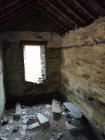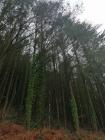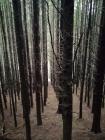Our Experience at Corris
Items in this story:
As a part of the Unlocking the Sound Heritage project, a few members of the group decided to go and visit Corris Village. The visit was organised to familiarise some of the group members with the area and location of the village of Corris, giving an insight for the interviews that were to be digitised at the National Library of Wales as part of the Unlocking Our Sound Heritage Project. Corris village is surrounded by the Dyfi Forest, which is part of Snowdonia National Park which covers 823 square metres. Corris Village lays on the edge of the National Park. In the past Corris village had a history with quarrying slate. The Braich Goch Slate Quarry Co. which was established in 1864, was a successful quarrying company, this was due to the use of the Corris Railway, which was built in 1859. This railway allowed the transportation of slate. Towards the 1930s large areas of the forest surrounding Corris was taken over by the Forestry Commission. The steam train also helped with the forestry work, transporting forestry remains from Corris to Maespoeth.
Leaving Aberystwyth we navigate through the steep-sided and winding roads that draw you up into the mountains and down into Corris. The village appears suddenly, nestled within a steep valley that is bordered by thick forest woodland. The town itself is quiet and built in grey stone that is so ubiquitous to Wales. The weather is beginning to close in as we get out of the car, the clouds low and heavy with rain. We set off along the road and go down into the village along the zigzag path that mirrors the jagged shapes in the quarries that lie in the hills surrounding. Walking through the village you get the feeling that not much has changed throughout the years. The cottages have a sleepy yet comforting presence among the slate grey quarries and the stone-grey sky. Leaving the centre we walk up a steep path that leads us into the thick trees. Suddenly the light dims and the silence falls like a blanket. No birds nest in the trees. There aren’t any shrubs for smaller animals to shelter under. The forest is desolate of sound. Suddenly the shapes of ruins emerge. The trees paint a picture of the past industry and the forgotten community of workers. The path winds up and over into a small hollow. We find ourselves sitting among the ruins of the old housing. The roof, long collapsed and the windows looking out with an empty stare. As the path drops lower, we emerge from the darkness and quietness of the forest, out into a wider valley. The sky still grey and low, we make our way back to the main road and the waiting car.
Corris may be a small town, hidden from the larger world, but the Unlocking Our Sound Heritage project is drawing those stories out from the valley and into homes across Wales, the United Kingdom and to future researchers from all backgrounds. This was a rewarding journey because sometimes, sitting in an enclosed room under fluorescent lights puts a mental distance between the work being done and the real people that contributed to the stories. Before the journey to Corris, the places that the interviewees referred to in the interviews were just words on an audio recording. Walking through Corris helped us to see where some of the stories captured on the oral interviews had taken place and it brought a satisfaction to know that other people would soon have access to them. After experiencing the forests of Corris, we were able to go back to the project at the National Library of Wales with renewed drive and focus. We could imagine what the events described by the interviewees might have looked like and picture exactly where it would have all happened. This appreciation for the extent of the project served as a way to recognize the impact of the work being done and our own value and role in being part of that continuing story.







